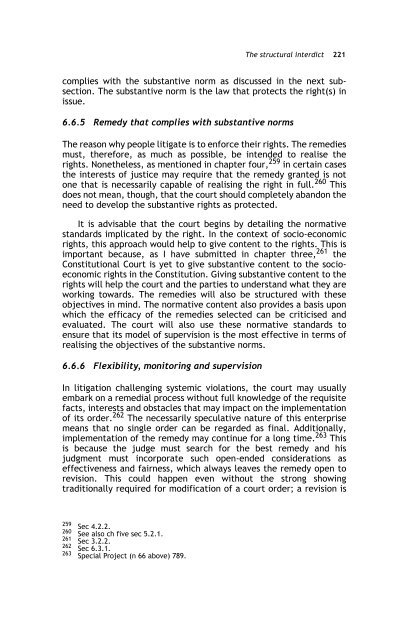LITIGATING SOCIO-ECONOMIC RIGHTS IN SOUTH AFRICA - PULP
LITIGATING SOCIO-ECONOMIC RIGHTS IN SOUTH AFRICA - PULP
LITIGATING SOCIO-ECONOMIC RIGHTS IN SOUTH AFRICA - PULP
Create successful ePaper yourself
Turn your PDF publications into a flip-book with our unique Google optimized e-Paper software.
The structural interdict 221<br />
complies with the substantive norm as discussed in the next subsection.<br />
The substantive norm is the law that protects the right(s) in<br />
issue.<br />
6.6.5 Remedy that complies with substantive norms<br />
The reason why people litigate is to enforce their rights. The remedies<br />
must, therefore, as much as possible, be intended to realise the<br />
rights. Nonetheless, as mentioned in chapter four, 259 in certain cases<br />
the interests of justice may require that the remedy granted is not<br />
one that is necessarily capable of realising the right in full. 260 This<br />
does not mean, though, that the court should completely abandon the<br />
need to develop the substantive rights as protected.<br />
It is advisable that the court begins by detailing the normative<br />
standards implicated by the right. In the context of socio-economic<br />
rights, this approach would help to give content to the rights. This is<br />
important because, as I have submitted in chapter three, 261 the<br />
Constitutional Court is yet to give substantive content to the socioeconomic<br />
rights in the Constitution. Giving substantive content to the<br />
rights will help the court and the parties to understand what they are<br />
working towards. The remedies will also be structured with these<br />
objectives in mind. The normative content also provides a basis upon<br />
which the efficacy of the remedies selected can be criticised and<br />
evaluated. The court will also use these normative standards to<br />
ensure that its model of supervision is the most effective in terms of<br />
realising the objectives of the substantive norms.<br />
6.6.6 Flexibility, monitoring and supervision<br />
In litigation challenging systemic violations, the court may usually<br />
embark on a remedial process without full knowledge of the requisite<br />
facts, interests and obstacles that may impact on the implementation<br />
of its order. 262 The necessarily speculative nature of this enterprise<br />
means that no single order can be regarded as final. Additionally,<br />
implementation of the remedy may continue for a long time. 263 This<br />
is because the judge must search for the best remedy and his<br />
judgment must incorporate such open-ended considerations as<br />
effectiveness and fairness, which always leaves the remedy open to<br />
revision. This could happen even without the strong showing<br />
traditionally required for modification of a court order; a revision is<br />
259<br />
Sec 4.2.2.<br />
260 See also ch five sec 5.2.1.<br />
261 Sec 3.2.2.<br />
262<br />
Sec 6.3.1.<br />
263 Special Project (n 66 above) 789.
















